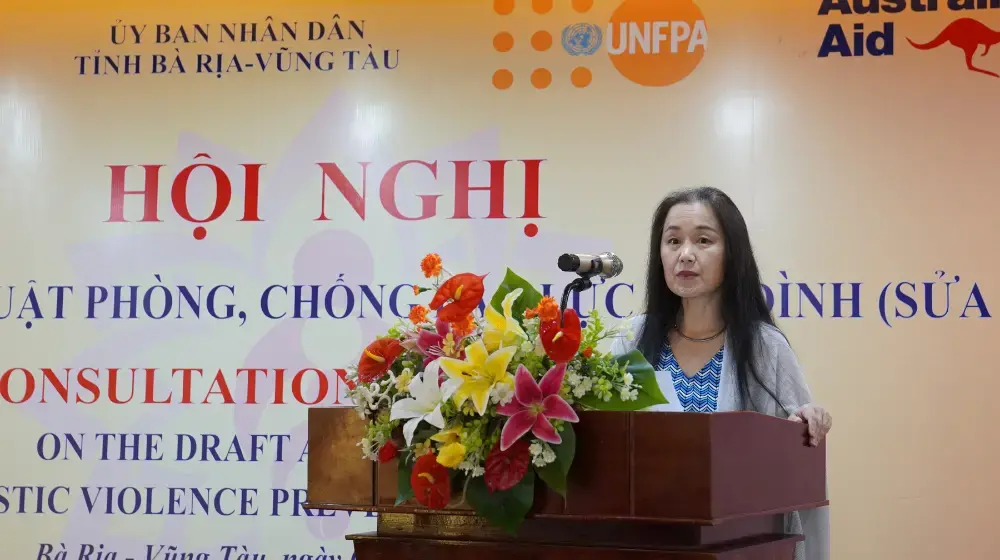HA NOI, 14 July 2020 – The National Study on Violence Against Women conducted in Viet Nam has yielded a comprehensive and updated picture of this scourge, one that the Government and partners are determined to address all the more effectively going forward, to build on progress made in recent years.
The study, whose results were launched today, shows that nearly two in three married women (almost 63 per cent) have experienced one or more forms of physical, sexual, emotional and economic violence and controlling behaviours by their husbands in their lifetime, and almost 32 per cent in the last 12 months.
Viet Nam is the only country in the world so far which has conducted a second dedicated study specifically using cross-culturally validated methodology developed by the World Health Organization.
This study was managed by the Ministry of Labour, Invalids and Social Affairs – MOLISA, in collaboration with the General Statistics Office, with technical and financial support from UNFPA and Australia’s Department of Foreign Affairs and Trade (DFAT). This study enables a better understanding of what has changed since the first study in 2010, as well as what has not, and what needs to be in place for strengthening gender equality and ending gender-based violence in Viet Nam.
The 2019 study has three parts: a quantitative survey, conducted by the General Statistics Office; a qualitative study by the Center for Creative Initiatives in Health and Population - CCIHP; and an economic costing of violence by international experts commissioned by UNFPA.
Nearly 6,000 women aged 15 to 64 were interviewed, with the results showing that in Viet Nam most of the violence against women is perpetrated by their husbands or partners.
The study also shows that with the exception of sexual violence, the prevalence of different types of violence against women, perpetrated by husbands, was slightly lower in 2019 than in 2010, and positive change may be happening among younger women.
In addition, the report estimated that violence against women cost Viet Nam an estimated 1.8 per cent of its Gross Domestic Product (GDP) in 2018.
“After nearly ten years since the first survey, the results show both positive changes and shortcomings. Overall, the percentage of women suffering from these forms of violence has decreased slightly. Positive change is clearly seen among young women who did not endure and showed their strength in fighting against violence. Women who have higher education are less likely to experience violence. This shows that education is very important in helping women to be stronger, more confident and independent in life. However, many women are still vulnerable to violence. Violence against women remains hidden because gender stereotypes are still common in society. Silence, stigma from the community and a culture of blame are barriers that prevent the survivors from speaking out and seeking help. Children are also victims, more vulnerable to violence, especially when they witness domestic violence against their mothers,” explained Nguyen Thi Ha, Vice Minister, MOLISA/ Standing Vice Chairman of the National Committee for the Advancement of Women in Viet Nam.
“These shortcomings and challenges need to be thoroughly addressed by the government agencies as well as the socio-political organizations, non-governmental organizations and each citizen in society,” she added.
“Ending violence against women and girls is one of the three transformative results that UNFPA has pledged to achieve worldwide,” noted Naomi Kitahara, UNFPA Representative in Viet Nam. “In Viet Nam, UNFPA has worked alongside the Government and stakeholders for more than a decade towards ending violence against women. Today, we have even more evidence to spur us to even greater action, and I call on everyone to join forces to eliminate this violence. Without addressing this, Viet Nam quite simply cannot achieve the 2030 Sustainable Development Agenda and its Sustainable Development Goals, and ensure no one is left behind.”
“Australia is deeply committed to ending gender-based violence,” said Robyn Mudie, Australian Ambassador to Viet Nam. “We have supported this study because it leads us all to acknowledge just how many lives are affected by violence, coercive control and harassment. Each piece of data in this report represents the experience of a Vietnamese woman or girl, whether in their home, at work or in a public place. This report means that we hear them, we believe them, and we need to act.”
Select key findings from the 2019 study:
- Nearly two-thirds (62.9 per cent) of women experienced at least one or more types of violence in their lifetime by their husband, and 31.6 per cent currently (i.e. in the last 12 months).
- Prevalence rates of all forms of violence against women by their husbands are slightly lower in 2019 than in 2010, except for rates of sexual violence. For instance, fewer women experienced physical violence by their husbands in their life time in 2019 (26.1 per cent) compared to 2010 (31.5 per cent). This was more prominent among younger women.
- However, more women reported experience of sexual violence by their husbands in their lifetime in 2019 (13.3 per cent) compared to 2010 (9.9 per cent). This was more prominent among younger women aged 18-24 (13.9 per cent in 2019 compared to 5.3 per cent in 2010). While this may reflect an increase in sexual violence, it may also be the result of social change where women are nowadays more open to talking about sex and sexual violence. Further research and analyses are necessary to establish a trend.
- Women with disabilities were more likely to experience all forms of violence by a husband than women without disabilities.
- Further, 4.4 per cent of women indicated that they had experienced child sexual abuse before the age 15.
- In Viet Nam, women were more likely to be abused by their husbands than by any other perpetrators. One in ten (11.4 per cent) women experienced physical violence since the age of 15 by a “non-partner”. The majority (60.6 per cent) of women who experienced non-partner violence mentioned that the perpetrator was male, often a male family member.
- Nearly one in ten (9 per cent) women experienced non-partner sexual violence since age 15. Almost all of this was perpetrated by males who were not family members (e.g. a male stranger, friend or acquaintance; a recent acquaintance; or someone at work).
- Violence against women remains very much hidden. Half of women who experienced violence by husbands had never told anyone. Almost all women (90.4 per cent) who experienced physical and/or sexual violence from husbands did not seek any help from formal service providers.
- Children are also victims when living in violent environments. Of the women who experienced physical violence by a husband, 61.4 per cent disclosed that their children witnessed or otherwise overheard the violence. Women who experienced physical and/or sexual violence by their husbands were more likely to say their children (5-12 years) had behavioural problems.
- Violence against women has serious consequences on economic development, as well as physical and mental health. It is costing Viet Nam’s national economy the equivalent of 1.8 per cent of GDP.
- Violence against women has a wide range of health impacts or consequences. One in four women (23.3 per cent) who were physically and/or sexually abused by their husbands had physical injuries. Pregnant women are also at risk of violence from their husbands.
- Violence is a learned behaviour. Women victims of violence are more likely to have a husband whose mother was beaten or who was himself beaten as a child. These learned behaviours can be prevented, and we must act now.
At today’s launch, the Government of Viet Nam, Government of Australia and UNFPA all called for ever more urgent action to end violence against women.
“No matter where violence happens, in what forms, or who it affects, it must be stopped,” concluded UNFPA Representative Naomi Kitahara. “Together, we should work to create a world where both women and men, and girls and boys, can enjoy a life free from violence. We commend Viet Nam for its commitment to achieving this vision.”
Today’s launch was live streamed and the recording can be accessed at the following links:
Vietnamese: https://www.facebook.com/unfpa.vietnam/
English: https://www.youtube.com/channel/UCfQ6WS9vUpeDGhwQ2nEV3aw
Click the following links to read the full report, summary report and other communications products relating to this national study:
MOLISA’s website: http://www.molisa.gov.vn and http://genic.molisa.gov.vn
UNFPA’s website: https://vietnam.unfpa.org/vi/publications (Vietnamese) or https://vietnam.unfpa.org/en/publications (English).
For further information, please contact:
Ms Nguyen Viet Hai, Gender Equality Department, Ministry of Labour, Invalids and Social Affairs
Email: hainv@molisa.gov.vn - Tel: +84 (0)24 3826 9551
Ms Nguyen Thi Hong Thanh | UNFPA Communications
Email: tnguyen@unfpa.org | Tel: +84 (0) 913 093 363





